2013 MERCEDES-BENZ CLA-CLASS automatic transmission
[x] Cancel search: automatic transmissionPage 232 of 352
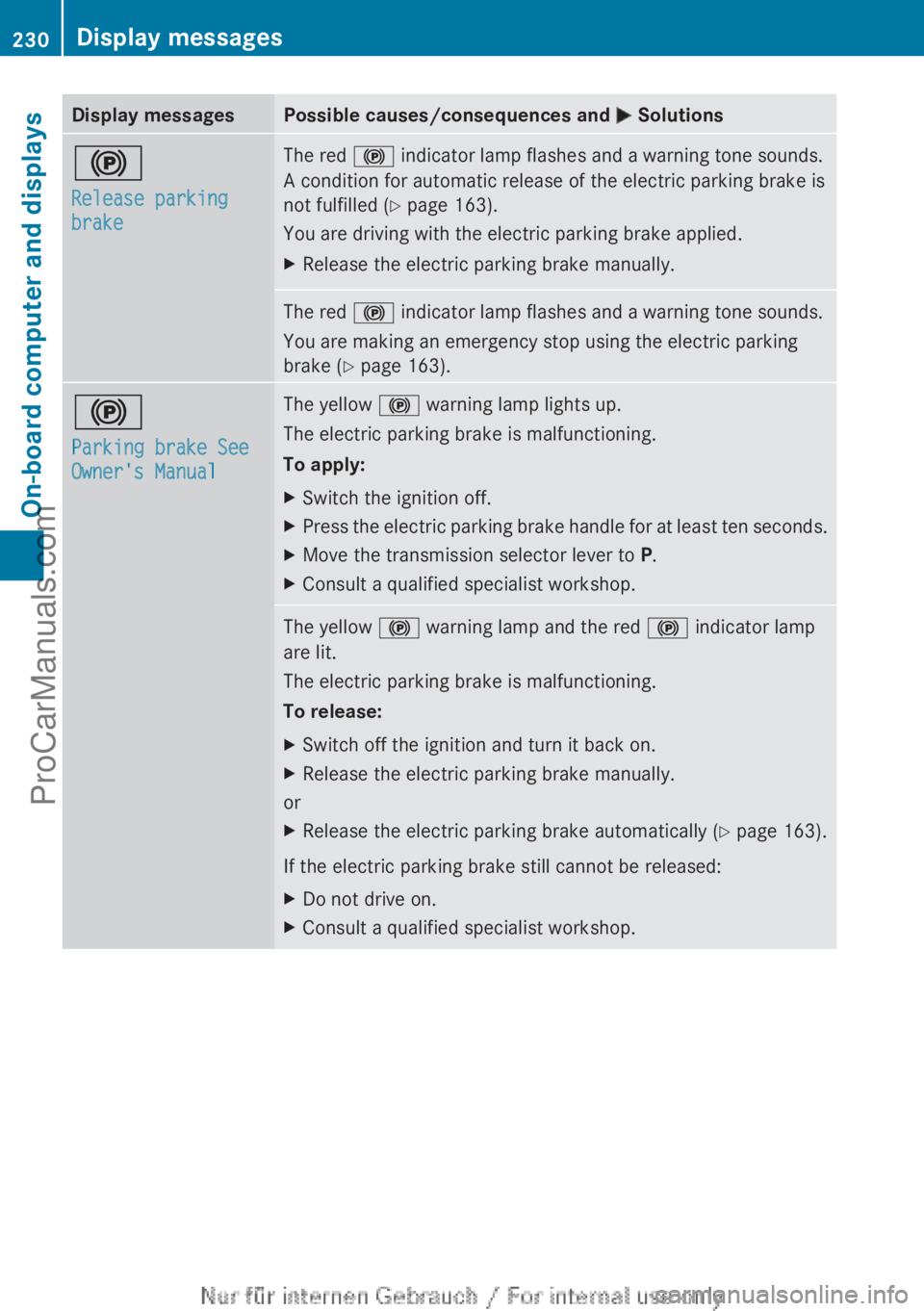
Display messagesPossible causes/consequences and M Solutions!
Release parking
brakeThe red ! indicator lamp flashes and a warning tone sounds.
A condition for automatic release of the electric parking brake is
not fulfilled ( Y page 163).
You are driving with the electric parking brake applied.XRelease the electric parking brake manually.The red ! indicator lamp flashes and a warning tone sounds.
You are making an emergency stop using the electric parking
brake ( Y page 163).!
Parking brake See
Owner's ManualThe yellow ! warning lamp lights up.
The electric parking brake is malfunctioning.
To apply:XSwitch the ignition off.XPress the electric parking brake handle for at least ten seconds.XMove the transmission selector lever to P.XConsult a qualified specialist workshop.The yellow ! warning lamp and the red ! indicator lamp
are lit.
The electric parking brake is malfunctioning.
To release:XSwitch off the ignition and turn it back on.XRelease the electric parking brake manually.
or
XRelease the electric parking brake automatically ( Y page 163).
If the electric parking brake still cannot be released:
XDo not drive on.XConsult a qualified specialist workshop.230Display messagesOn-board computer and displays
ProCarManuals.com
Page 233 of 352
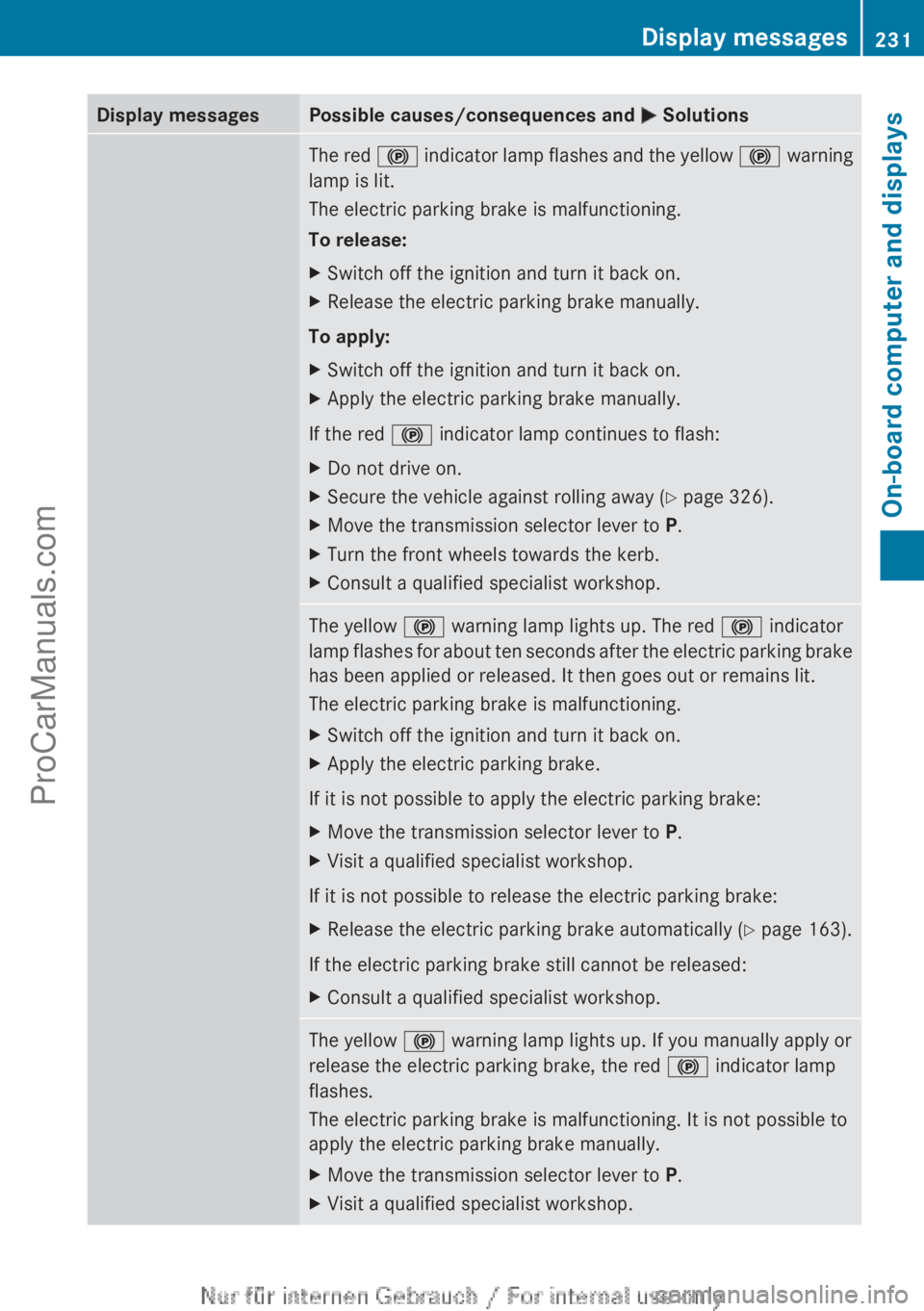
Display messagesPossible causes/consequences and M SolutionsThe red ! indicator lamp flashes and the yellow ! warning
lamp is lit.
The electric parking brake is malfunctioning.
To release:XSwitch off the ignition and turn it back on.XRelease the electric parking brake manually.
To apply:
XSwitch off the ignition and turn it back on.XApply the electric parking brake manually.
If the red ! indicator lamp continues to flash:
XDo not drive on.XSecure the vehicle against rolling away ( Y page 326).XMove the transmission selector lever to P.XTurn the front wheels towards the kerb.XConsult a qualified specialist workshop.The yellow ! warning lamp lights up. The red ! indicator
lamp flashes for about ten seconds after the electric parking brake
has been applied or released. It then goes out or remains lit.
The electric parking brake is malfunctioning.XSwitch off the ignition and turn it back on.XApply the electric parking brake.
If it is not possible to apply the electric parking brake:
XMove the transmission selector lever to P.XVisit a qualified specialist workshop.
If it is not possible to release the electric parking brake:
XRelease the electric parking brake automatically ( Y page 163).
If the electric parking brake still cannot be released:
XConsult a qualified specialist workshop.The yellow ! warning lamp lights up. If you manually apply or
release the electric parking brake, the red ! indicator lamp
flashes.
The electric parking brake is malfunctioning. It is not possible to
apply the electric parking brake manually.XMove the transmission selector lever to P.XVisit a qualified specialist workshop.Display messages231On-board computer and displaysZProCarManuals.com
Page 252 of 352
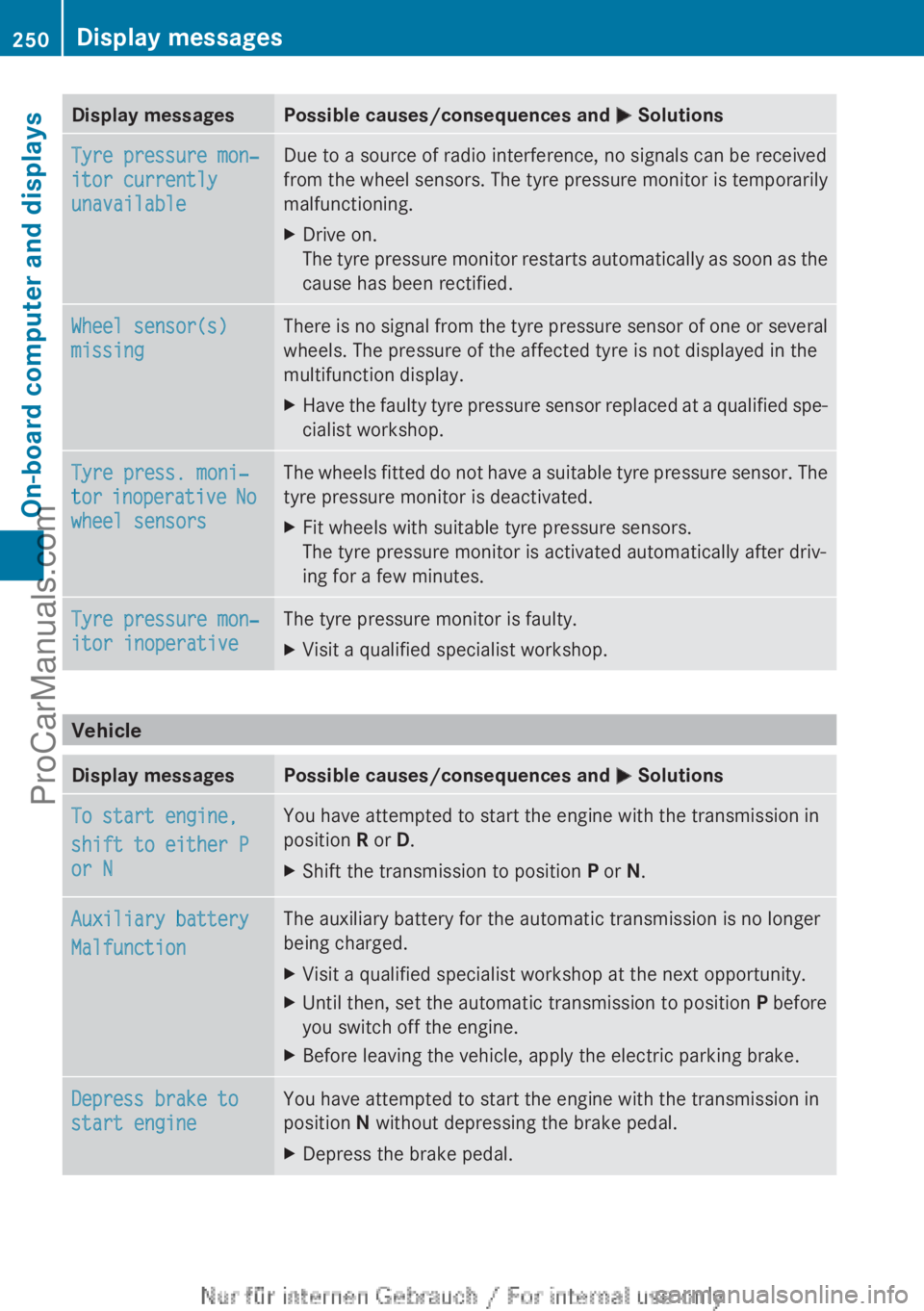
Display messagesPossible causes/consequences and M SolutionsTyre pressure mon‐
itor currently
unavailableDue to a source of radio interference, no signals can be received
from the wheel sensors. The tyre pressure monitor is temporarily
malfunctioning.XDrive on.
The tyre pressure monitor restarts automatically as soon as the
cause has been rectified.Wheel sensor(s)
missingThere is no signal from the tyre pressure sensor of one or several
wheels. The pressure of the affected tyre is not displayed in the
multifunction display.XHave the faulty tyre pressure sensor replaced at a qualified spe-
cialist workshop.Tyre press. moni‐
tor inoperative No
wheel sensorsThe wheels fitted do not have a suitable tyre pressure sensor. The
tyre pressure monitor is deactivated.XFit wheels with suitable tyre pressure sensors.
The tyre pressure monitor is activated automatically after driv-
ing for a few minutes.Tyre pressure mon‐
itor inoperativeThe tyre pressure monitor is faulty.XVisit a qualified specialist workshop.
Vehicle
Display messagesPossible causes/consequences and M SolutionsTo start engine,
shift to either P
or NYou have attempted to start the engine with the transmission in
position R or D.XShift the transmission to position P or N.Auxiliary battery
MalfunctionThe auxiliary battery for the automatic transmission is no longer
being charged.XVisit a qualified specialist workshop at the next opportunity.XUntil then, set the automatic transmission to position P before
you switch off the engine.XBefore leaving the vehicle, apply the electric parking brake.Depress brake to
start engineYou have attempted to start the engine with the transmission in
position N without depressing the brake pedal.XDepress the brake pedal.250Display messagesOn-board computer and displays
ProCarManuals.com
Page 253 of 352
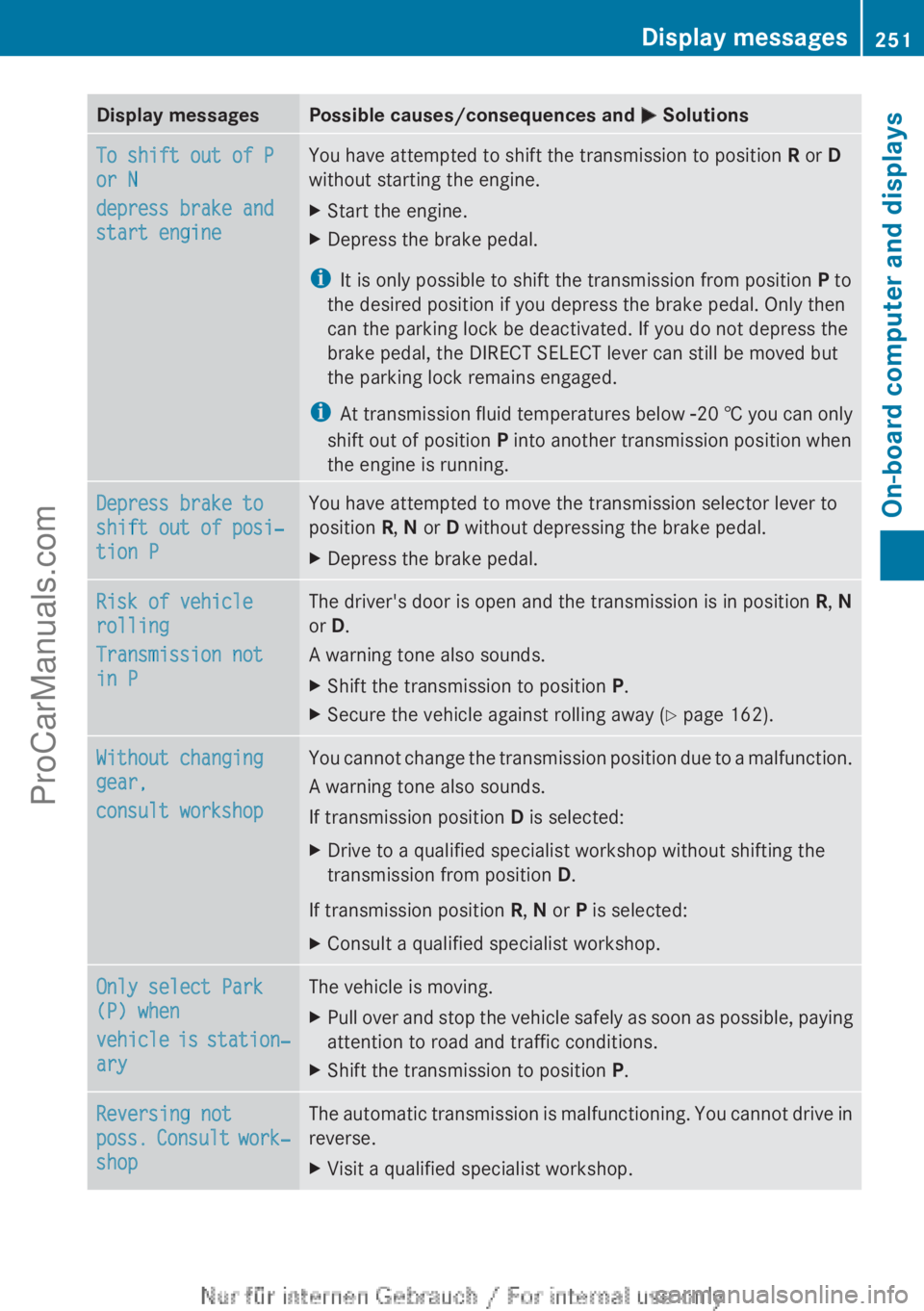
Display messagesPossible causes/consequences and M SolutionsTo shift out of P
or N
depress brake and
start engineYou have attempted to shift the transmission to position R or D
without starting the engine.XStart the engine.XDepress the brake pedal.
i It is only possible to shift the transmission from position P to
the desired position if you depress the brake pedal. Only then
can the parking lock be deactivated. If you do not depress the
brake pedal, the DIRECT SELECT lever can still be moved but
the parking lock remains engaged.
i At transmission fluid temperatures below Ò20 † you can only
shift out of position P into another transmission position when
the engine is running.
Depress brake to
shift out of posi‐
tion PYou have attempted to move the transmission selector lever to
position R, N or D without depressing the brake pedal.XDepress the brake pedal.Risk of vehicle
rolling
Transmission not
in PThe driver's door is open and the transmission is in position R, N
or D.
A warning tone also sounds.XShift the transmission to position P.XSecure the vehicle against rolling away ( Y page 162).Without changing
gear,
consult workshopYou cannot change the transmission position due to a malfunction.
A warning tone also sounds.
If transmission position D is selected:XDrive to a qualified specialist workshop without shifting the
transmission from position D.
If transmission position R, N or P is selected:
XConsult a qualified specialist workshop.Only select Park
(P) when
vehicle is station‐
aryThe vehicle is moving.XPull over and stop the vehicle safely as soon as possible, paying
attention to road and traffic conditions.XShift the transmission to position P.Reversing not
poss. Consult work‐
shopThe automatic transmission is malfunctioning. You cannot drive in
reverse.XVisit a qualified specialist workshop.Display messages251On-board computer and displaysZProCarManuals.com
Page 254 of 352
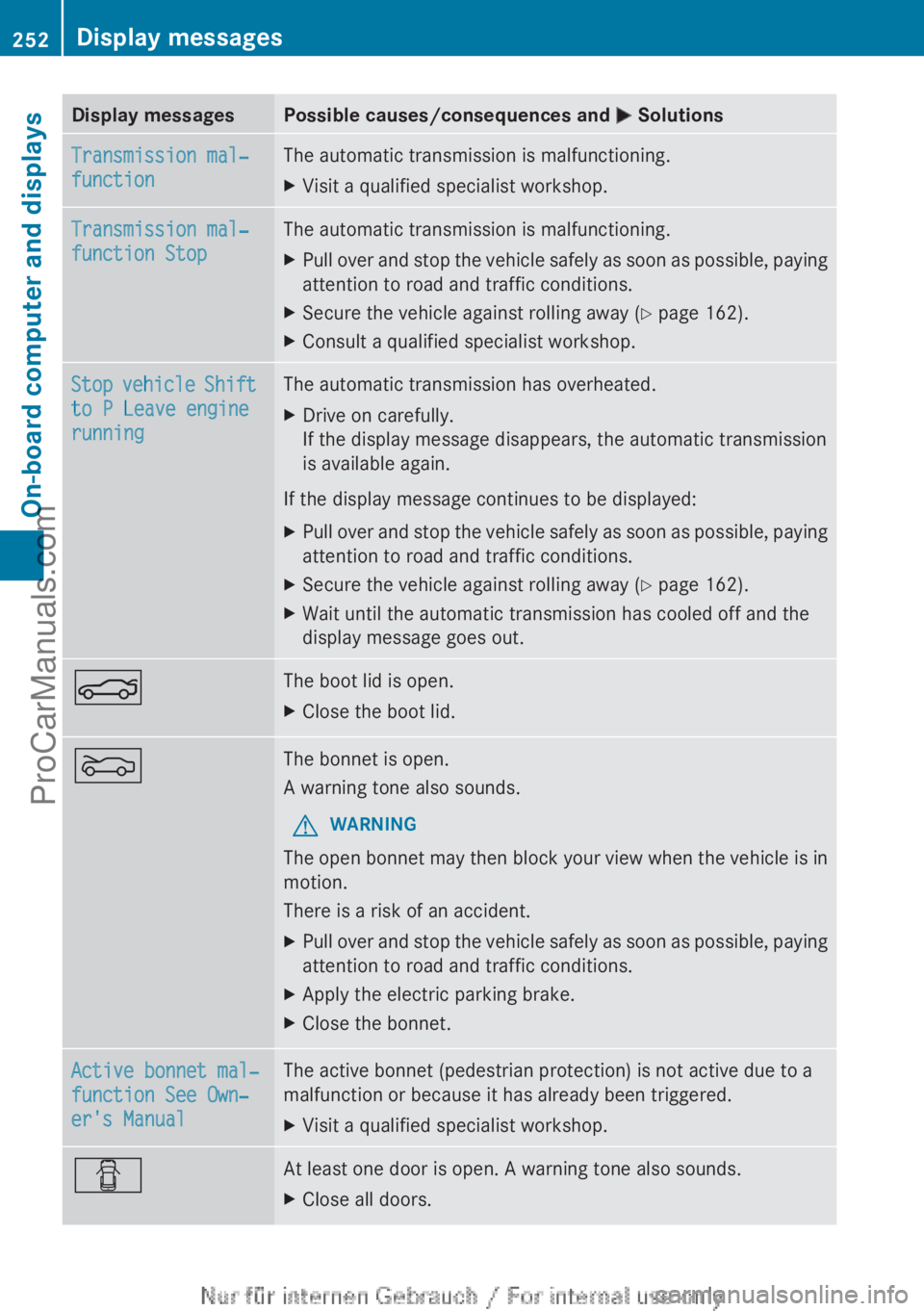
Display messagesPossible causes/consequences and M SolutionsTransmission mal‐
functionThe automatic transmission is malfunctioning.XVisit a qualified specialist workshop.Transmission mal‐
function StopThe automatic transmission is malfunctioning.XPull over and stop the vehicle safely as soon as possible, paying
attention to road and traffic conditions.XSecure the vehicle against rolling away ( Y page 162).XConsult a qualified specialist workshop.Stop vehicle Shift
to P Leave engine
runningThe automatic transmission has overheated.XDrive on carefully.
If the display message disappears, the automatic transmission
is available again.
If the display message continues to be displayed:
XPull over and stop the vehicle safely as soon as possible, paying
attention to road and traffic conditions.XSecure the vehicle against rolling away ( Y page 162).XWait until the automatic transmission has cooled off and the
display message goes out.NThe boot lid is open.XClose the boot lid.MThe bonnet is open.
A warning tone also sounds.GWARNING
The open bonnet may then block your view when the vehicle is in
motion.
There is a risk of an accident.
XPull over and stop the vehicle safely as soon as possible, paying
attention to road and traffic conditions.XApply the electric parking brake.XClose the bonnet.Active bonnet mal‐
function See Own‐
er's ManualThe active bonnet (pedestrian protection) is not active due to a
malfunction or because it has already been triggered.XVisit a qualified specialist workshop.CAt least one door is open. A warning tone also sounds.XClose all doors.252Display messagesOn-board computer and displays
ProCarManuals.com
Page 290 of 352
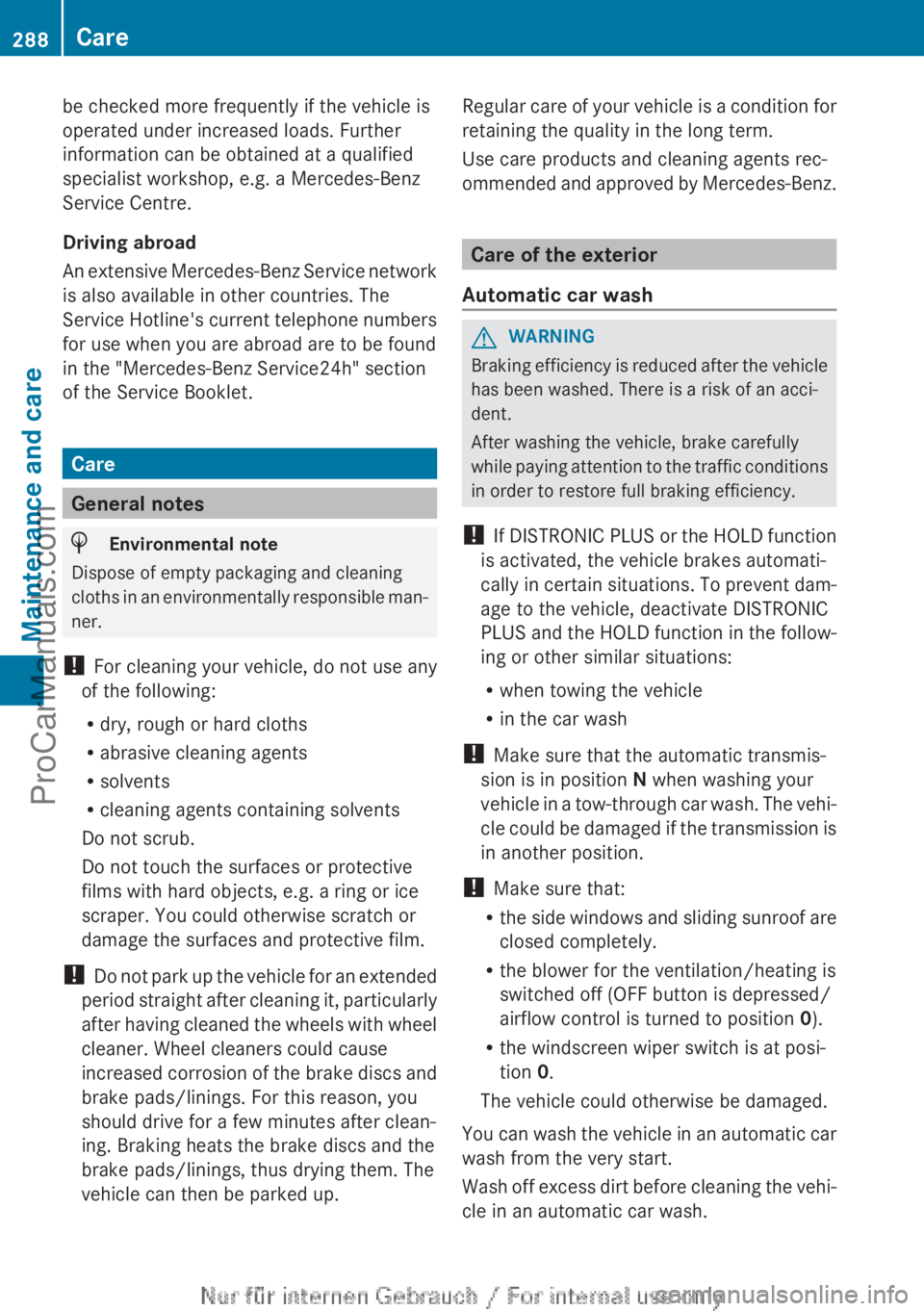
be checked more frequently if the vehicle is
operated under increased loads. Further
information can be obtained at a qualified
specialist workshop, e.g. a Mercedes-Benz
Service Centre.
Driving abroad
An extensive Mercedes-Benz Service network
is also available in other countries. The
Service Hotline's current telephone numbers
for use when you are abroad are to be found
in the "Mercedes-Benz Service24h" section
of the Service Booklet.
Care
General notes
HEnvironmental note
Dispose of empty packaging and cleaning
cloths in an environmentally responsible man-
ner.
! For cleaning your vehicle, do not use any
of the following:
R dry, rough or hard cloths
R abrasive cleaning agents
R solvents
R cleaning agents containing solvents
Do not scrub.
Do not touch the surfaces or protective
films with hard objects, e.g. a ring or ice
scraper. You could otherwise scratch or
damage the surfaces and protective film.
! Do not park up the vehicle for an extended
period straight after cleaning it, particularly
after having cleaned the wheels with wheel
cleaner. Wheel cleaners could cause
increased corrosion of the brake discs and
brake pads/linings. For this reason, you
should drive for a few minutes after clean-
ing. Braking heats the brake discs and the
brake pads/linings, thus drying them. The
vehicle can then be parked up.
Regular care of your vehicle is a condition for
retaining the quality in the long term.
Use care products and cleaning agents rec-
ommended and approved by Mercedes-Benz.
Care of the exterior
Automatic car wash
GWARNING
Braking efficiency is reduced after the vehicle
has been washed. There is a risk of an acci-
dent.
After washing the vehicle, brake carefully
while paying attention to the traffic conditions
in order to restore full braking efficiency.
! If DISTRONIC PLUS or the HOLD function
is activated, the vehicle brakes automati-
cally in certain situations. To prevent dam-
age to the vehicle, deactivate DISTRONIC
PLUS and the HOLD function in the follow-
ing or other similar situations:
R when towing the vehicle
R in the car wash
! Make sure that the automatic transmis-
sion is in position N when washing your
vehicle in a tow-through car wash. The vehi-
cle could be damaged if the transmission is
in another position.
! Make sure that:
R the side windows and sliding sunroof are
closed completely.
R the blower for the ventilation/heating is
switched off (OFF button is depressed/
airflow control is turned to position 0).
R the windscreen wiper switch is at posi-
tion 0.
The vehicle could otherwise be damaged.
You can wash the vehicle in an automatic car
wash from the very start.
Wash off excess dirt before cleaning the vehi-
cle in an automatic car wash.
288CareMaintenance and care
ProCarManuals.com
Page 305 of 352
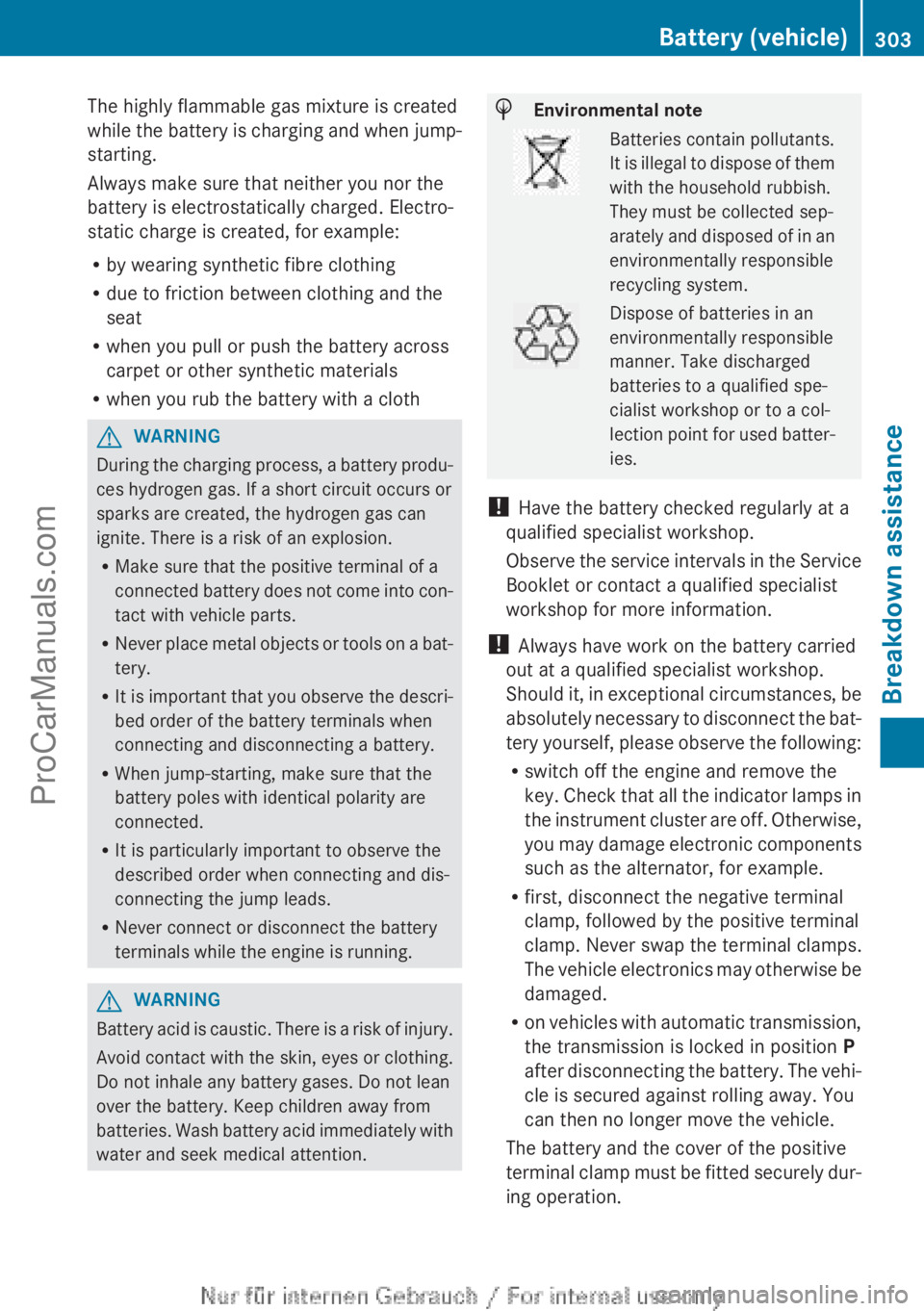
The highly flammable gas mixture is created
while the battery is charging and when jump-
starting.
Always make sure that neither you nor the
battery is electrostatically charged. Electro-
static charge is created, for example:
R by wearing synthetic fibre clothing
R due to friction between clothing and the
seat
R when you pull or push the battery across
carpet or other synthetic materials
R when you rub the battery with a clothGWARNING
During the charging process, a battery produ-
ces hydrogen gas. If a short circuit occurs or
sparks are created, the hydrogen gas can
ignite. There is a risk of an explosion.
R Make sure that the positive terminal of a
connected battery does not come into con-
tact with vehicle parts.
R Never place metal objects or tools on a bat-
tery.
R It is important that you observe the descri-
bed order of the battery terminals when
connecting and disconnecting a battery.
R When jump-starting, make sure that the
battery poles with identical polarity are
connected.
R It is particularly important to observe the
described order when connecting and dis-
connecting the jump leads.
R Never connect or disconnect the battery
terminals while the engine is running.
GWARNING
Battery acid is caustic. There is a risk of injury.
Avoid contact with the skin, eyes or clothing.
Do not inhale any battery gases. Do not lean
over the battery. Keep children away from
batteries. Wash battery acid immediately with
water and seek medical attention.
HEnvironmental noteBatteries contain pollutants.
It is illegal to dispose of them
with the household rubbish.
They must be collected sep-
arately and disposed of in an
environmentally responsible
recycling system.Dispose of batteries in an
environmentally responsible
manner. Take discharged
batteries to a qualified spe-
cialist workshop or to a col-
lection point for used batter-
ies.
! Have the battery checked regularly at a
qualified specialist workshop.
Observe the service intervals in the Service
Booklet or contact a qualified specialist
workshop for more information.
! Always have work on the battery carried
out at a qualified specialist workshop.
Should it, in exceptional circumstances, be
absolutely necessary to disconnect the bat-
tery yourself, please observe the following:
R switch off the engine and remove the
key. Check that all the indicator lamps in
the instrument cluster are off. Otherwise,
you may damage electronic components
such as the alternator, for example.
R first, disconnect the negative terminal
clamp, followed by the positive terminal
clamp. Never swap the terminal clamps.
The vehicle electronics may otherwise be
damaged.
R on vehicles with automatic transmission,
the transmission is locked in position P
after disconnecting the battery. The vehi-
cle is secured against rolling away. You
can then no longer move the vehicle.
The battery and the cover of the positive
terminal clamp must be fitted securely dur-
ing operation.
Battery (vehicle)303Breakdown assistanceZProCarManuals.com
Page 309 of 352
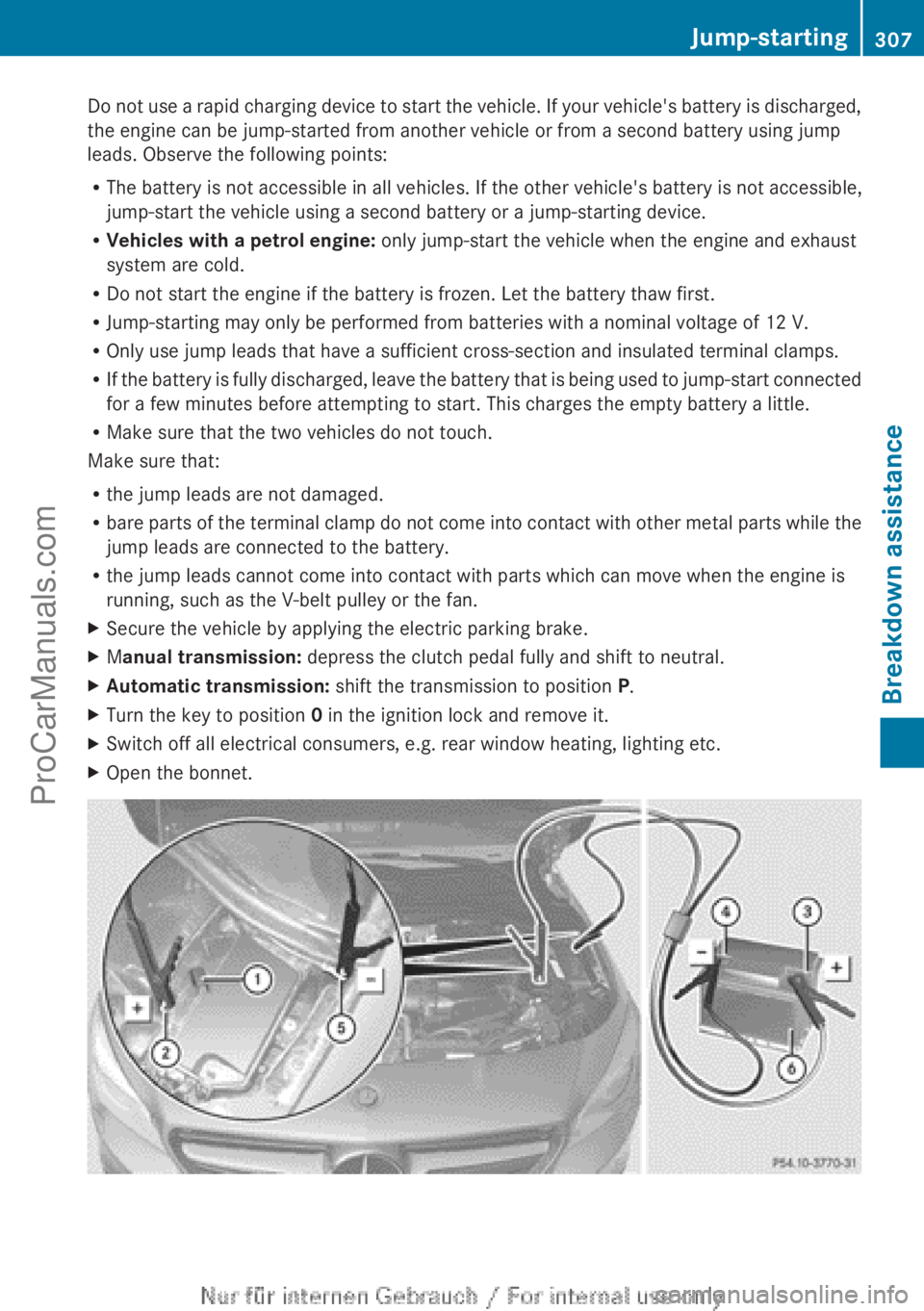
Do not use a rapid charging device to start the vehicle. If your vehicle's battery is discharged,
the engine can be jump-started from another vehicle or from a second battery using jump
leads. Observe the following points:
R The battery is not accessible in all vehicles. If the other vehicle's battery is not accessible,
jump-start the vehicle using a second battery or a jump-starting device.
R Vehicles with a petrol engine: only jump-start the vehicle when the engine and exhaust
system are cold.
R Do not start the engine if the battery is frozen. Let the battery thaw first.
R Jump-starting may only be performed from batteries with a nominal voltage of 12 V.
R Only use jump leads that have a sufficient cross-section and insulated terminal clamps.
R If the battery is fully discharged, leave the battery that is being used to jump-start connected
for a few minutes before attempting to start. This charges the empty battery a little.
R Make sure that the two vehicles do not touch.
Make sure that:
R the jump leads are not damaged.
R bare parts of the terminal clamp do not come into contact with other metal parts while the
jump leads are connected to the battery.
R the jump leads cannot come into contact with parts which can move when the engine is
running, such as the V-belt pulley or the fan.XSecure the vehicle by applying the electric parking brake.XM anual transmission: depress the clutch pedal fully and shift to neutral.XAutomatic transmission: shift the transmission to position P.XTurn the key to position 0 in the ignition lock and remove it.XSwitch off all electrical consumers, e.g. rear window heating, lighting etc.XOpen the bonnet.Jump-starting307Breakdown assistanceZProCarManuals.com